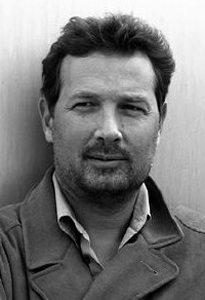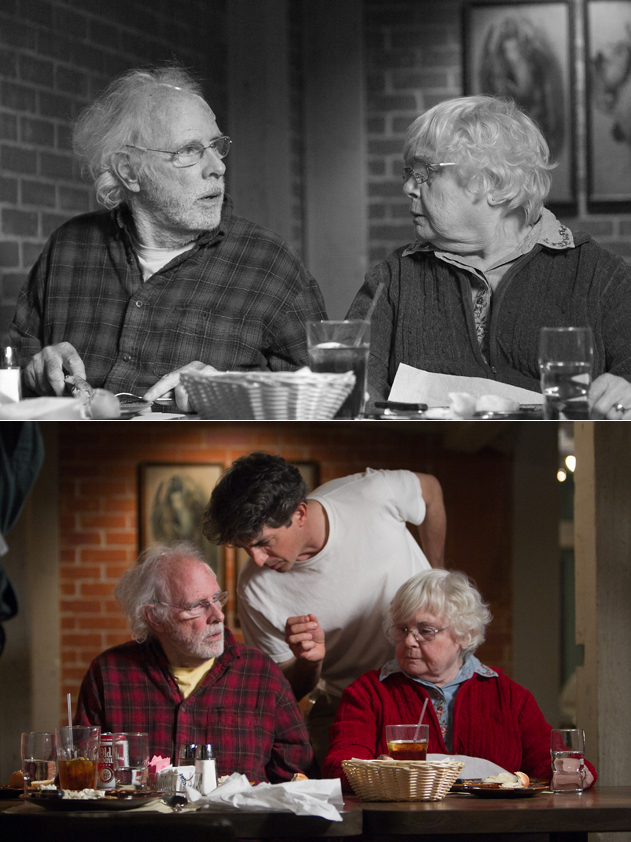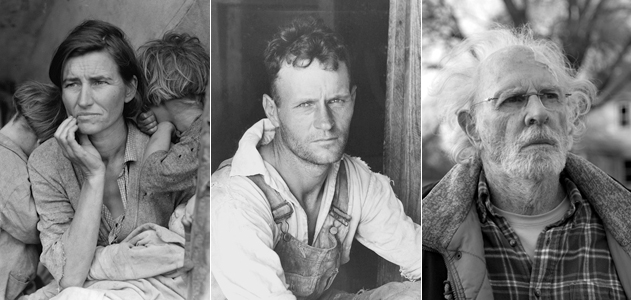 Like many filmmakers of his generation, cinematographer Phedon Papamichael began his career working for Roger Corman. But his apprenticeship didn’t last long. After DP’ing films like Stripped to Kill II: Live Girls and Dance of the Damned, both released in 1989, he began working with director Jon Turteltaub on more, let’s say, reputable titles like Cool Runnings, While Your Were Sleeping, and Phenomenon. In all, between 1991-1996, Papamichael worked with Turteltaub four times while also lensing a crazy-quilt of films, ranging from Bio-Dome and Patch Adams to Wim Wenders’ Million Dollar Hotel and the underrated Moonlight Mile.
Like many filmmakers of his generation, cinematographer Phedon Papamichael began his career working for Roger Corman. But his apprenticeship didn’t last long. After DP’ing films like Stripped to Kill II: Live Girls and Dance of the Damned, both released in 1989, he began working with director Jon Turteltaub on more, let’s say, reputable titles like Cool Runnings, While Your Were Sleeping, and Phenomenon. In all, between 1991-1996, Papamichael worked with Turteltaub four times while also lensing a crazy-quilt of films, ranging from Bio-Dome and Patch Adams to Wim Wenders’ Million Dollar Hotel and the underrated Moonlight Mile.
But it was when he worked with director James Mangold on the 2003 film Identity that Papamichael’s career hit another gear. He collaborated with Mangold three more times (so far), including on the remake of 3:10 to Yuma, which is one of the more beautiful films of the last decade. He also worked with Oliver Stone on W., and struck up a relationship with Alexander Payne after shooting Sideways. The collaboration has led to excellent work in The Descendants (where he met George Clooney, who would draft Papamichael to shoot The Ides of March and The Monuments Men) and his first Academy Award nomination for his sumptuous black-and-white photography on Nebraska.
A few days before the Blu-Ray release of Nebraska, which is available now, Camera in the Sun spoke with Papamichael for a February 2014 interview about the film, shooting in color for black and white, giving a digital shoot a vintage film look, choosing the locations to give the film its vérité quality, and his chances at Sunday’s Oscar ceremony. Here’s an edited and condensed transcript of our conversation.
First, congratulations on the Oscar nomination.
Thank you very much.
It’s a pretty crowded field, how do you like your chances?
Well, you know, there’s this whole argument about, we’ve had about three or four years in a row where a heavily CG-generated film wins, and I think we’re going to see a repeat this year with Gravity and Emmanuel Lubezki is going to take it. But, you know, it’s nice… I mean, we’ve had Avatar, Hugo, Life of Pi, and there’s this argument whether they should create a new category or put them in with visual effects. At least in Chivo’s case, he was very involved with [Gravity director] Alfonso [Cuaron) and the CG guys creating the things it accomplished. But I’m very happy and very excited. We’re the smallest movie. We had $12 million and 35 days. And also to get a visual recognition for an Alexander Payne movie was… He’s obviously an amazing filmmaker, but he’s not really known for, it’s not like you’re working with [David] Fincher or somebody where every year they get a cinematography nomination. So I’m really happy, and I’m happy for him because I know it’s important to him and he’s proud of it, to have gotten some cinematography recognition, which he’s never had before with any other movie.
That’s surprising to hear. His films tend to be consistent in that they’re beautifully photographed.
When I read the script, I realized that it had all the qualities of the characters and intimate story and the little interactions between the characters that he usually has. But it also felt more cinematic. Maybe it’s the setting. Of course the black and white, the choice of black and white, which he always envisioned his film in black and white since its conception when he first read it. He first talked to me about this movie on Sideways, so we’ve been keeping this one alive for 10 years now. I’m glad he was stubborn enough and insisted on doing it in black and white. I don’t know if you know, but Paramount wasn’t initially too thrilled about it just because they said it will limit their sales and it probably finds a different audience. But now we’ve come full circle and everybody loves the film and I think its found its identity in black and white and hopefully we won’t have to show it in a color version, which we have as well. But, you know, I think now people just recognize it as a black and white piece.
Yeah, I read that you shot it in color and then converted it to black and white…
Yeah, we had to because we had to deliver a color version. I still started testing 5220, that’s the black and white Kodak stock, and used that as a reference and the digital intermediate and shot color stock, 5219, and then Alexa, as well, then settled on the Alexa just because it gave us some other advantages like shooting higher speed and, you know, we’re a lot in the car with very minimal lighting, if any, and all real locations. Typically with Alexander, we actually never really build any sets. We’re always looking to find real locations, and the digital camera helped us there because I’m able to rate it at 1000 ASA and I’m using old anamorphic Panavision C Series lenses, which are not that fast, they’re T4, and that’s again where the speed helps us on the camera. You know, black and white film stock didn’t have that much latitude in the old days, so I don’t really mind that it doesn’t hold all the details in the high end. With that particular look that we created, which is higher contrast black and white, the digital camera worked out really nice.
What was that experience like for you shooting a film digitally in color knowing that it’s going to be converted to black and white with film grain added later through a digital process, versus just shooting it on color for color or black and white for black and white?
Well, it actually worked out pretty nice because I used this Sony OLED monitor on set which has very good blacks and I create the lookup table that reflects what our final product is going to be. It helps, actually, communicating with Alexander because we’re looking at the black and white image the entire time we’re filming and we can work in black and white. It only exists for us in black and white, all our rushes are in black and white. But on set, it helps with the lighting because we’re looking at the image and this is the first time… Traditionally with Alexander, we don’t have a video village and he’s always next to camera and just works with me next to camera operating this whole show per his request. So we create this really small, intimate environment, this little film family that’s basically, when we’re recording, it’s just the boom guy, a sound man, first assistant, and the actors, and then we have the monitor there so we’re able to discuss the look and how dark we want things to go and how contrasty or if someone’s saying “silhouette,” I can just show him, and I think it facilitated the whole collaboration.
How does the film play in color? I’m assuming it never screened in color, but you were looking at color footage. How does it look, how does it feel?
Well, to tell you the truth, I never saw a color version. We concentrated our efforts, of course, on the black and white. So I used up all my time to perfect the black and white look. But, you know, adding film grain, we asked Paramount to send a print of Paper Moon so we could analyze the grain the structure of that. It’s interesting because you forget how alive those film print were and how much movement there is. I didn’t want to overdo it with adding the grain, but it was nice to put it up on the screen and parallel screen them and dial that in. Those were two movies we did look at, of course Paper Moon and Last Picture Show, so that was sort of the world we were in, cinematically. In terms of the color, I never saw it. Alexander did see it. He goes, “It’s nice, I kind of like it.” I go, “Well, I hope you don’t like it better than the black and white.” He didn’t. But actually my colorist Skip Kimball at Technicolor, I said to him, “Alright, now do the color version,” and as I was walking out the door said, “Do whatever you always wanted to do and were never allowed to do.” I don’t know if anybody will ever see it. Maybe. I hope in a way not, because nobody wants to see Manhattan or Raging Bull or Good Night, and Good Luck. in color. So hopefully the film has found its identity as one of the black and white classics. We hope.
In a previous interview, you said there was a black and white film print of Nebraska struck but it never screened…
Yes. Alexander always has in his contract that he gets to keep a print. I’ve asked him if he has a projector. He said no. But being a traditionalist filmmaker, he insists on having his prints. So we did actually make 10 showprints on black-and-white print stock, which I’m sure are gorgeous. I have to admit I haven’t had the opportunity yet to see one. But of course I think that’s really going to help even further disguise the fact that we shot digitally because you’re picking up the actual print stock grain and the projector movement and projector flicker. I’m sure it’s a beautiful thing to see, and I’m hoping to be able to view one of those in the near future.
You mentioned all the locations are real places. What were you looking for when you went around with Alexander to find places for this film?
Alexander, obviously being from Nebraska, is very familiar with the communities and the various small towns that we pieced our Hawthorne together [with]. But he’s always looking for… He has this dogma about things being real. We very rarely do any major changes to the set. When we find a bar, we use the bar with its decor in place. When we shoot, for example, the restaurant where karaoke takes place, that’s a restaurant we ate at when we scouted. He likes the authenticity of things and we really don’t create a different kind of world to the degree that he casts a lot of local people, like the waitresses who serves [Woody and David] at the karaoke bar is actually a waitress at that restaurant. The bar lady who serves them their first beer together actually owns and runs that bar. So, yeah, it’s important to him to create a real-feeling environment.
I mean, of course it’s stylized in the black and white, but he’s very familiar with Nebraska, and what we did as our preparation was we actually drove the full route from Billings, Montana, all the way down to Norfolk, Nebraska. And that was less to specifically find locations. He just wanted me to get an impression of the land and sort of the vast expanse and how long you actually travel from one place to another. And a lot of those first impressions were very significant for me in terms of understanding that particular region and how the society really lives and acts. One of the things I noticed when we were driving through these towns, it said “Population 12,000” or “15,000,” then you would go down Main Street and one of my first impressions was how devoid of people it was, which was interesting. If you see the movie, we never really needed any extras on the street or anything because it just feels like these towns are abandoned, although they have quite a high number of people living there. And I’d say to Alexander, “Where is everybody?” It was a nice, 70 degrees spring day. “I guess they’re inside watching TV.” It’s ironic, later, we have all these scenes where people are in their houses watching TV, when they talk they don’t really make eye contact. So all these little nuances that are characteristic for the midwest, I suppose. It’s always nice feedback when you get the local community really responding to the material. And people who grew up and have a lot of people in the region, whether it’s my agent or someone else who grew up in a similar society, and they’re really affected by the film. They go, “Wow, you guys really captured something that feels very real.” They all have some relatives that are similar to Woody or a father or an uncle who grew up kind of like that, and they’re really very emotional about the film.
That happens with Alexander. We try to capture the essence of the region we shoot in. It was the same on The Descendants and Hawaii. We get all the time from people who live in Hawaii and the islands that we found a way to show Hawaii that’s not typically represented or the general perception of what it is, whether it’s a representation that shows the full aspect of society, the contrast between rich and poor or how it’s not always sunny there. (laughs) So it’s always very nice feedback to get when people from the actual place where we shot are feeling like we captured some essence of their lives. And it helps integrating all these local people. It’s nice because he does casting calls out to the farming community and we get a lot of people who are non-actors and we mix them in with our actors, like the Westendorfs, those are real farmers, and like I said, the bar lady, the waitress, the old man who walks up to Woody on the bench, these are all local non-actors. So we blend them in with our professional actors and we create this tone that you get that feels authentic.
Yeah, there’s a documentary quality to the film, which is certainly helped by the black and white, and especially in the black and white it feels like old photography. Watching the film, I wondered if your background in photojournalism kicked in at all when you were making Nebraska, or if you drew on a photographer like Walker Evans or Dorothea Lange who captured that same part of the country.
Yeah, I mean, look, my background, like you mentioned is still photography, and of course anyone who starts… When I started at 14 with my cameras, you start in black and white. Plus I’m from a generation where our film language, our film history, whatever we were exposed to influenced us growing up, I mean myself and Alexander included. Our black and white films, starting with the westerns and, of course, me growing up in Europe I was heavily influenced and loved all the films of the French New Wave, Godard, Truffaut, and then Buñuel and Fellini, of course. I grew up in Munich, so later on there was Wim Wenders, Alice in the Cities, Kings of the Road, and the Japanese films, Ozu and Kurosawa. So all those things are influences. We didn’t look for specifically famous American still photographers, but now having done this movie, of course, I read about them all the time, they’re referred to in connection to Nebraska, and I look them up and I have discovered all these photographers that I go, “Oh yeah, that looks just like Nebraska.” But, you know, you have it in your subconsciousness, all of these images exist somewhere in little drawers in our mind.
And of course, that landscape and the vast horizon of the sky, the little figures, these faces — Woody’s face, his white, glowing hair, the texture of his skin — really allows you to tune in on the performances. And as Alexander said, I forget who said it, some director said black and white is the actor’s best friend*, and I really think there’s some truth in that. Without the distraction of color palettes, it really allows you to hone into these subtle little performances that Woody and everybody gives. His little moments of confusion or fear or anger, all that is aided by the black and white. And we did put more emphasis on composition in this film. I mean, we always do, but the pace of editing is slower so you have more time to take in these compositions. We try to let scenes play out in oners or with just very few shots. So you have these wide shots that set up the land and then we selectively go into closeups, we don’t really overuse closeups. We save the moments when we go in close to allow them to have more impact, and I think that’s all been achieved.
*It’s an Orson Welles quote.
Photos: Paramount Pictures (Nebraska), Library of Congress (Dorothea Lange, Walker Evans)





